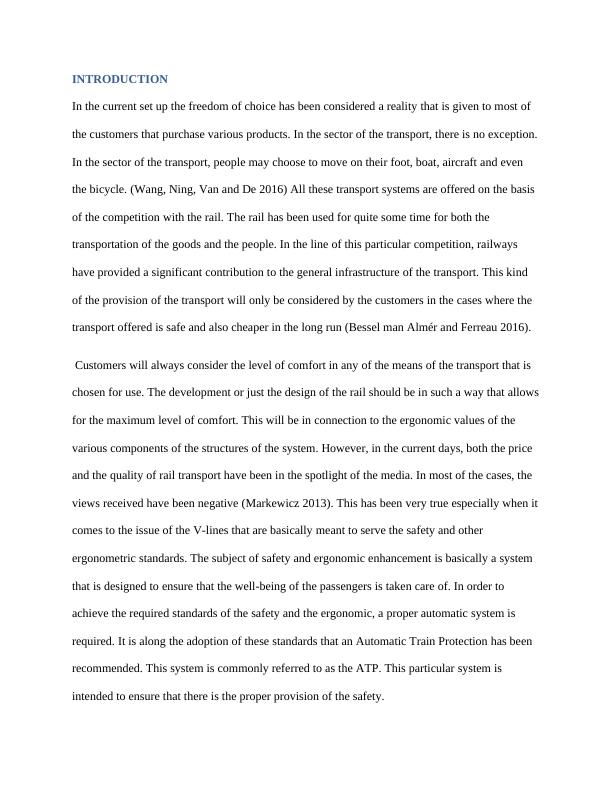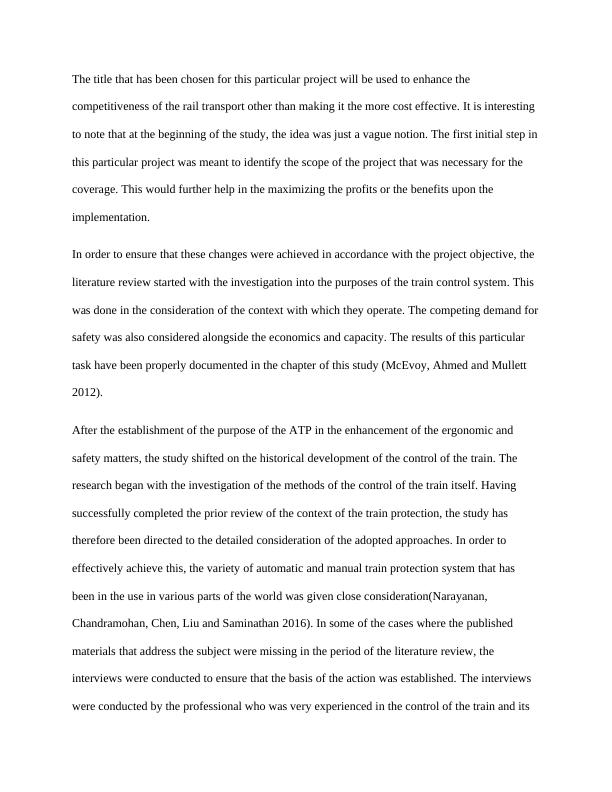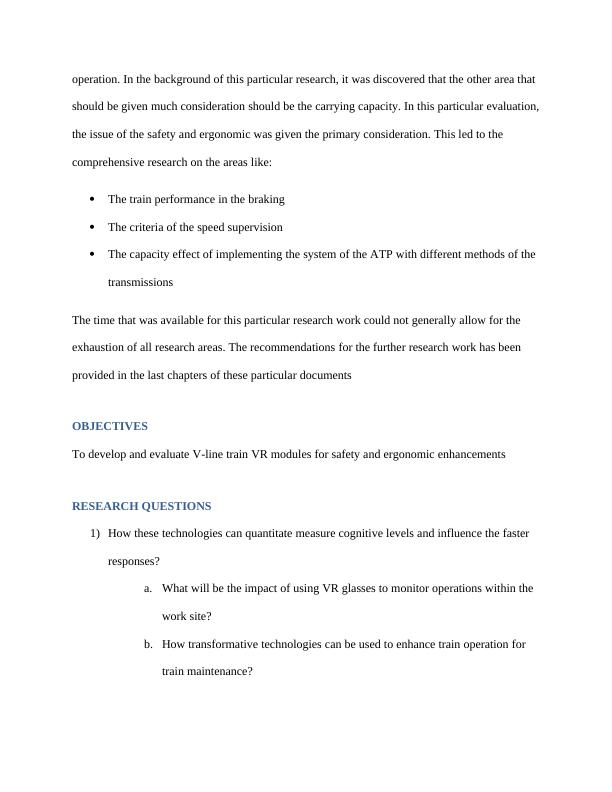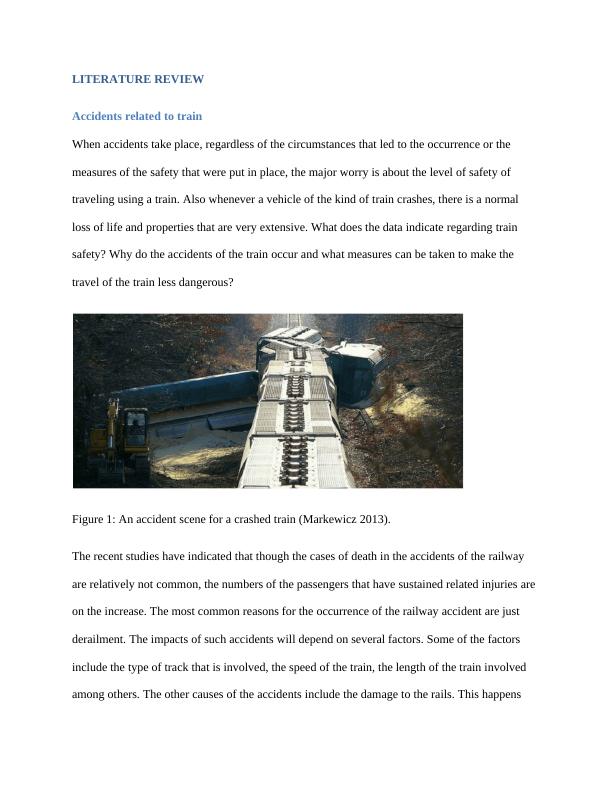Develop and Evaluate V-line train VR modules for safety and ergonomic enhancement
60 Pages15232 Words97 Views
Added on 2023-03-23
About This Document
This project aims to develop and evaluate V-line train VR modules for enhancing safety and ergonomic standards. The project will explore the use of VR glasses for monitoring train operations and improving train maintenance. The research will focus on quantifying cognitive levels and measuring faster responses using VR technology. The study will also investigate the impact of transformative technologies on train operation and maintenance.
Develop and Evaluate V-line train VR modules for safety and ergonomic enhancement
Added on 2023-03-23
ShareRelated Documents
Develop and Evaluate V-line train VR modules for safety and ergonomic enhancement
Student Name –
Student ID –
Project Supervisor –
Unit Code –
Unit Name – Final Year Research Project 1
Unit Convener - Dr Kenneth Igbo
Institution – Swinburne University of Technology
Student Name –
Student ID –
Project Supervisor –
Unit Code –
Unit Name – Final Year Research Project 1
Unit Convener - Dr Kenneth Igbo
Institution – Swinburne University of Technology

Location - Hawthorn
Date – 29 October 2018
ABSTRACT
In the sector of the transport, people may choose to move on their foot, boat, aircraft and even
the bicycle. (Wang, Ning, Van and De 2016) All these transport systems are offered on the basis
of the competition with the rail. The rail has been used for quite some time for both the
transportation of the goods and the people. In the line of this particular competition, railways
have provided a significant contribution to the general infrastructure of the transport. In order to
ensure that these changes were achieved in accordance with the project objective, the literature
review started with the investigation into the purposes of the train control system. This was done
in the consideration of the context with which they operate.
The competing demand for safety was also considered alongside the economics and capacity.
The results of this particular task have been properly documented in the chapter of this study
(McEvoy, Ahmed and Mullett 2012). The recent studies have indicated that though the cases of
Date – 29 October 2018
ABSTRACT
In the sector of the transport, people may choose to move on their foot, boat, aircraft and even
the bicycle. (Wang, Ning, Van and De 2016) All these transport systems are offered on the basis
of the competition with the rail. The rail has been used for quite some time for both the
transportation of the goods and the people. In the line of this particular competition, railways
have provided a significant contribution to the general infrastructure of the transport. In order to
ensure that these changes were achieved in accordance with the project objective, the literature
review started with the investigation into the purposes of the train control system. This was done
in the consideration of the context with which they operate.
The competing demand for safety was also considered alongside the economics and capacity.
The results of this particular task have been properly documented in the chapter of this study
(McEvoy, Ahmed and Mullett 2012). The recent studies have indicated that though the cases of

death in the accidents of the railway are relatively not common, the numbers of the passengers
that have sustained related injuries are on the increase.
The most common reasons for the occurrence of the railway accident are just derailment. The
impacts of such accidents will depend on several factors. Some of the factors include the type of
track that is involved, the speed of the train, the length of the train involved among others. The
other causes of the accidents include the damage to the rails. This happens when the rails
experience bearing failures and also defects of malfunctioning. The identification of such errors
can be done through the use of the Operational Error (OE).
Contents
ABSTRACT....................................................................................................................................2
INTRODUCTION...........................................................................................................................4
OBJECTIVES..................................................................................................................................6
RESEARCH QUESTIONS.............................................................................................................6
LITERATURE REVIEW................................................................................................................7
Accidents related to training 7
Sociotechnical System Approach.................................................................................................9
Function-behavior-Structure Framework...................................................................................12
that have sustained related injuries are on the increase.
The most common reasons for the occurrence of the railway accident are just derailment. The
impacts of such accidents will depend on several factors. Some of the factors include the type of
track that is involved, the speed of the train, the length of the train involved among others. The
other causes of the accidents include the damage to the rails. This happens when the rails
experience bearing failures and also defects of malfunctioning. The identification of such errors
can be done through the use of the Operational Error (OE).
Contents
ABSTRACT....................................................................................................................................2
INTRODUCTION...........................................................................................................................4
OBJECTIVES..................................................................................................................................6
RESEARCH QUESTIONS.............................................................................................................6
LITERATURE REVIEW................................................................................................................7
Accidents related to training 7
Sociotechnical System Approach.................................................................................................9
Function-behavior-Structure Framework...................................................................................12

The human factors and train.......................................................................................................13
Rail Safety..................................................................................................................................14
Rail Capacity..............................................................................................................................17
Platform management................................................................................................................18
Training for critical events.........................................................................................................19
The emergence of VR (Training in Virtual Environment)........................................................20
Presence in the Training.........................................................................................................23
METHODOLOGY........................................................................................................................27
Participants.................................................................................................................................28
VR glasses design......................................................................................................................28
Design Procedure.......................................................................................................................28
RESULTS......................................................................................................................................33
DISCUSSION................................................................................................................................34
Subsystem view..........................................................................................................................39
PROJECT MANAGEMENT.........................................................................................................41
Constraints.................................................................................................................................42
Gantt chart..................................................................................................................................42
CONCLUSION..............................................................................................................................43
REFERENCES..............................................................................................................................47
Rail Safety..................................................................................................................................14
Rail Capacity..............................................................................................................................17
Platform management................................................................................................................18
Training for critical events.........................................................................................................19
The emergence of VR (Training in Virtual Environment)........................................................20
Presence in the Training.........................................................................................................23
METHODOLOGY........................................................................................................................27
Participants.................................................................................................................................28
VR glasses design......................................................................................................................28
Design Procedure.......................................................................................................................28
RESULTS......................................................................................................................................33
DISCUSSION................................................................................................................................34
Subsystem view..........................................................................................................................39
PROJECT MANAGEMENT.........................................................................................................41
Constraints.................................................................................................................................42
Gantt chart..................................................................................................................................42
CONCLUSION..............................................................................................................................43
REFERENCES..............................................................................................................................47

INTRODUCTION
In the current set up the freedom of choice has been considered a reality that is given to most of
the customers that purchase various products. In the sector of the transport, there is no exception.
In the sector of the transport, people may choose to move on their foot, boat, aircraft and even
the bicycle. (Wang, Ning, Van and De 2016) All these transport systems are offered on the basis
of the competition with the rail. The rail has been used for quite some time for both the
transportation of the goods and the people. In the line of this particular competition, railways
have provided a significant contribution to the general infrastructure of the transport. This kind
of the provision of the transport will only be considered by the customers in the cases where the
transport offered is safe and also cheaper in the long run (Bessel man Almér and Ferreau 2016).
Customers will always consider the level of comfort in any of the means of the transport that is
chosen for use. The development or just the design of the rail should be in such a way that allows
for the maximum level of comfort. This will be in connection to the ergonomic values of the
various components of the structures of the system. However, in the current days, both the price
and the quality of rail transport have been in the spotlight of the media. In most of the cases, the
views received have been negative (Markewicz 2013). This has been very true especially when it
comes to the issue of the V-lines that are basically meant to serve the safety and other
ergonometric standards. The subject of safety and ergonomic enhancement is basically a system
that is designed to ensure that the well-being of the passengers is taken care of. In order to
achieve the required standards of the safety and the ergonomic, a proper automatic system is
required. It is along the adoption of these standards that an Automatic Train Protection has been
recommended. This system is commonly referred to as the ATP. This particular system is
intended to ensure that there is the proper provision of the safety.
In the current set up the freedom of choice has been considered a reality that is given to most of
the customers that purchase various products. In the sector of the transport, there is no exception.
In the sector of the transport, people may choose to move on their foot, boat, aircraft and even
the bicycle. (Wang, Ning, Van and De 2016) All these transport systems are offered on the basis
of the competition with the rail. The rail has been used for quite some time for both the
transportation of the goods and the people. In the line of this particular competition, railways
have provided a significant contribution to the general infrastructure of the transport. This kind
of the provision of the transport will only be considered by the customers in the cases where the
transport offered is safe and also cheaper in the long run (Bessel man Almér and Ferreau 2016).
Customers will always consider the level of comfort in any of the means of the transport that is
chosen for use. The development or just the design of the rail should be in such a way that allows
for the maximum level of comfort. This will be in connection to the ergonomic values of the
various components of the structures of the system. However, in the current days, both the price
and the quality of rail transport have been in the spotlight of the media. In most of the cases, the
views received have been negative (Markewicz 2013). This has been very true especially when it
comes to the issue of the V-lines that are basically meant to serve the safety and other
ergonometric standards. The subject of safety and ergonomic enhancement is basically a system
that is designed to ensure that the well-being of the passengers is taken care of. In order to
achieve the required standards of the safety and the ergonomic, a proper automatic system is
required. It is along the adoption of these standards that an Automatic Train Protection has been
recommended. This system is commonly referred to as the ATP. This particular system is
intended to ensure that there is the proper provision of the safety.

The title that has been chosen for this particular project will be used to enhance the
competitiveness of the rail transport other than making it the more cost effective. It is interesting
to note that at the beginning of the study, the idea was just a vague notion. The first initial step in
this particular project was meant to identify the scope of the project that was necessary for the
coverage. This would further help in the maximizing the profits or the benefits upon the
implementation.
In order to ensure that these changes were achieved in accordance with the project objective, the
literature review started with the investigation into the purposes of the train control system. This
was done in the consideration of the context with which they operate. The competing demand for
safety was also considered alongside the economics and capacity. The results of this particular
task have been properly documented in the chapter of this study (McEvoy, Ahmed and Mullett
2012).
After the establishment of the purpose of the ATP in the enhancement of the ergonomic and
safety matters, the study shifted on the historical development of the control of the train. The
research began with the investigation of the methods of the control of the train itself. Having
successfully completed the prior review of the context of the train protection, the study has
therefore been directed to the detailed consideration of the adopted approaches. In order to
effectively achieve this, the variety of automatic and manual train protection system that has
been in the use in various parts of the world was given close consideration(Narayanan,
Chandramohan, Chen, Liu and Saminathan 2016). In some of the cases where the published
materials that address the subject were missing in the period of the literature review, the
interviews were conducted to ensure that the basis of the action was established. The interviews
were conducted by the professional who was very experienced in the control of the train and its
competitiveness of the rail transport other than making it the more cost effective. It is interesting
to note that at the beginning of the study, the idea was just a vague notion. The first initial step in
this particular project was meant to identify the scope of the project that was necessary for the
coverage. This would further help in the maximizing the profits or the benefits upon the
implementation.
In order to ensure that these changes were achieved in accordance with the project objective, the
literature review started with the investigation into the purposes of the train control system. This
was done in the consideration of the context with which they operate. The competing demand for
safety was also considered alongside the economics and capacity. The results of this particular
task have been properly documented in the chapter of this study (McEvoy, Ahmed and Mullett
2012).
After the establishment of the purpose of the ATP in the enhancement of the ergonomic and
safety matters, the study shifted on the historical development of the control of the train. The
research began with the investigation of the methods of the control of the train itself. Having
successfully completed the prior review of the context of the train protection, the study has
therefore been directed to the detailed consideration of the adopted approaches. In order to
effectively achieve this, the variety of automatic and manual train protection system that has
been in the use in various parts of the world was given close consideration(Narayanan,
Chandramohan, Chen, Liu and Saminathan 2016). In some of the cases where the published
materials that address the subject were missing in the period of the literature review, the
interviews were conducted to ensure that the basis of the action was established. The interviews
were conducted by the professional who was very experienced in the control of the train and its

operation. In the background of this particular research, it was discovered that the other area that
should be given much consideration should be the carrying capacity. In this particular evaluation,
the issue of the safety and ergonomic was given the primary consideration. This led to the
comprehensive research on the areas like:
The train performance in the braking
The criteria of the speed supervision
The capacity effect of implementing the system of the ATP with different methods of the
transmissions
The time that was available for this particular research work could not generally allow for the
exhaustion of all research areas. The recommendations for the further research work has been
provided in the last chapters of these particular documents
OBJECTIVES
To develop and evaluate V-line train VR modules for safety and ergonomic enhancements
RESEARCH QUESTIONS
1) How these technologies can quantitate measure cognitive levels and influence the faster
responses?
a. What will be the impact of using VR glasses to monitor operations within the
work site?
b. How transformative technologies can be used to enhance train operation for
train maintenance?
should be given much consideration should be the carrying capacity. In this particular evaluation,
the issue of the safety and ergonomic was given the primary consideration. This led to the
comprehensive research on the areas like:
The train performance in the braking
The criteria of the speed supervision
The capacity effect of implementing the system of the ATP with different methods of the
transmissions
The time that was available for this particular research work could not generally allow for the
exhaustion of all research areas. The recommendations for the further research work has been
provided in the last chapters of these particular documents
OBJECTIVES
To develop and evaluate V-line train VR modules for safety and ergonomic enhancements
RESEARCH QUESTIONS
1) How these technologies can quantitate measure cognitive levels and influence the faster
responses?
a. What will be the impact of using VR glasses to monitor operations within the
work site?
b. How transformative technologies can be used to enhance train operation for
train maintenance?

LITERATURE REVIEW
Accidents related to train
When accidents take place, regardless of the circumstances that led to the occurrence or the
measures of the safety that were put in place, the major worry is about the level of safety of
traveling using a train. Also whenever a vehicle of the kind of train crashes, there is a normal
loss of life and properties that are very extensive. What does the data indicate regarding train
safety? Why do the accidents of the train occur and what measures can be taken to make the
travel of the train less dangerous?
Figure 1: An accident scene for a crashed train (Markewicz 2013).
The recent studies have indicated that though the cases of death in the accidents of the railway
are relatively not common, the numbers of the passengers that have sustained related injuries are
on the increase. The most common reasons for the occurrence of the railway accident are just
derailment. The impacts of such accidents will depend on several factors. Some of the factors
include the type of track that is involved, the speed of the train, the length of the train involved
among others. The other causes of the accidents include the damage to the rails. This happens
Accidents related to train
When accidents take place, regardless of the circumstances that led to the occurrence or the
measures of the safety that were put in place, the major worry is about the level of safety of
traveling using a train. Also whenever a vehicle of the kind of train crashes, there is a normal
loss of life and properties that are very extensive. What does the data indicate regarding train
safety? Why do the accidents of the train occur and what measures can be taken to make the
travel of the train less dangerous?
Figure 1: An accident scene for a crashed train (Markewicz 2013).
The recent studies have indicated that though the cases of death in the accidents of the railway
are relatively not common, the numbers of the passengers that have sustained related injuries are
on the increase. The most common reasons for the occurrence of the railway accident are just
derailment. The impacts of such accidents will depend on several factors. Some of the factors
include the type of track that is involved, the speed of the train, the length of the train involved
among others. The other causes of the accidents include the damage to the rails. This happens

End of preview
Want to access all the pages? Upload your documents or become a member.
Related Documents
Developing and Evaluating V-line Train VR Modules for Safety and Ergonomic Enhancementlg...
|54
|13278
|143
